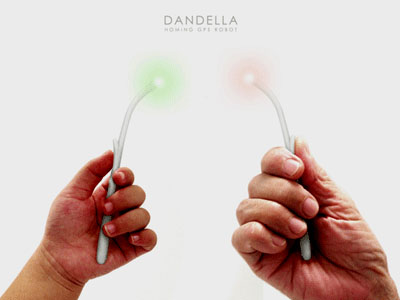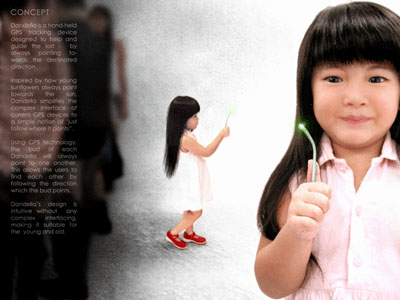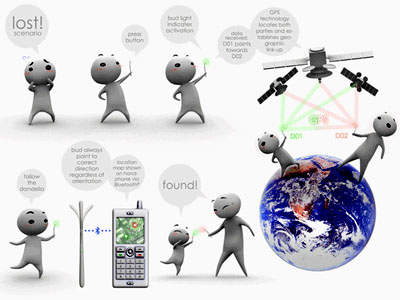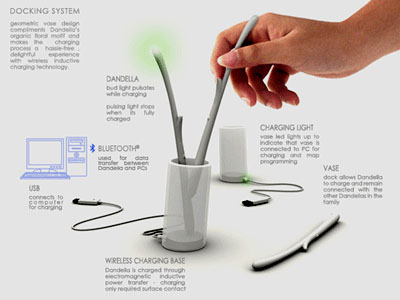

 subscribe
subscribeTitle: Dandella
Contents: Hand-held robotic GPS companion
Producers: Tan Yong Kai / Priscilla Lui Sik Peng
Implementability of proposal: Lost is a common global issue, especially for socially vulnerable people like young children and elderly in today's growing urban jungles.

"Dandella", adopting the metaphorical image of a dandelion in flight, is a GPS device which aims to provide a user-centric geo-tracking solution. Inspired by how young sunflowers always point towards the sun, Dandella simplifies the complex interface of current GPS devices to a notion of "follow where it points". Combining existing GPS and robotic technology, Dandellas can be programmed to track each other and their buds response by pointing towards one another. The intuitive design allows users to find each other by following where the bud points, making it suitable for people of different ages from different walks of life.

Just months from its inception, the NUS Design Incubation Centre (DIC) has hatched its first winner. It is indeed a golden egg: the Gold Prize from the International Design Competition Osaka 2006 presented by the Minister of Economy, Trade and Industry (Osaka).
Organized by the Japan Design Foundation (JDF), the International Design competition Osaka is one of the most prestigious design competitions. JDF seeks to provide more positive opportunities for business talks between designers and companies from the manufacturing and distribution industries, as well as facilitating the establishment of a system to commercialize the winning design ideas. For the 2006 competition, proposals were gathered from various global communities including industry, design, education, consumers, and governments, with an emphasis on those proposals that can promote new product development, new market exploration and show high potential to be commercialized within the next few years.

The main theme for the 2006 competition is “Robotâ€, with sub-themes “Communicateâ€, “Transport†and “Support†The emphasis is on the innovative use of robotic technology to help society. The workshop was held on February 1 and 2, 2007, at the Osaka International Convention Center. 19 finalists were invited to present their work to 160 business representatives in Japan. Another 48 excellent works were also introduced by panel exhibition. Participants came from countries renowned for design including Japan, Korea, China, Germany, France and Taiwan. At the Workshop, all excellent works were introduced via the invited producers' presentations and by panel display in the exhibition aria. In addition, individual business matchmaking meetings were held between the finalists and interested business representatives.

The NUS DIC team emerged the top winner, beating 424 entries with their design, the Dandella. Dandella is a hand-held GPS tracking device designed to help and guide the lost by always physically pointing towards the destination. Its name is derived from the metaphorical image of a dandelion in flight, floating towards its destination. The form is kept minimal and humble, likened to holding a flower in the hand. Inspired by how young sunflowers always point towards the sun, Dandella simplifies the complex interface of current GPS devices to a simple notion of ‘just follow where it pointsâ€.
Combining existing GPS and robotic technology, Dandella units can be programmed to track each other and their buds response by pointing towards one another. This intuitive design feature allows users to locate each other by following where the bud points, making it suitable for people of different ages from different walks of life.

Attuning to the theme of the competition, the DIC team touched on the concept of people to people interaction and location. As the team’s industrial designers put it:
“Getting lost is a common global issue, especially for socially vulnerable people like young children and elderly in today’s rapidly growing urban jungles. Dandella’s design is intuitive without any complex interfacing, making it suitable for the young and old. We wanted to solve a common social issue by first focusing on people’s needs and behaviors, then proposing a user-centric solution with the use of existing technology.â€
Representing the NUS DIC team for the competition are industrial designers: Tan Yong Kai and Priscilla Lui Sik Peng. Fresh out of the NUS School of Design and Environment, they joined the Design Incubation Centre, bringing a good track record of design achievements. “The whole experience of competing against the other designers from other countries is very fruitful because we get to experience different style of designs and school of thought. The exchange of ideas and cultural information is most enriching. The organizers are also very helpful, sincere and professional, making the whole event an unforgettable one.â€
The spirit of the competition is perhaps best summed up by Yong Kai’s response to the JDF’s panel jury: “Robots need not imitate aspects or motions of a human. Ultimately, their design should benefit mankind, as I was taught as a student.â€
The Design Incubation Centre is established by the NUS Department of Architecture, to promote, initiate and conduct design research and development activities as well as conduct symposiums and workshops for design and creative related professionals in the region, with a strong focus on Asia. With its triumph at Osaka, DIC is well on its way to become a regional and international leading establishment in Industrial design product development. Various parties from leading firms have already expressed interest to collaborate with DIC to commercialize the Dandella. This is the latest in a series of prestigious wins by the NUS Department of Architecture, which include the Electrolux Design Lab and Red Dot Award Design Concept awards. The DIC directors attribute this winning streak to the school’s outlook on designs: a humanizing approach and empathy with users, hence striking a cord of resonance with the international panel of judges.
For more information regarding the, please visit International Design Competition Osaka 2006
| Attachment | Size |
|---|---|
| show_imageA.jpg | 50.59 KB |
| show_image1.jpg | 63.78 KB |
| show_image2.jpg | 68.71 KB |
| show_image3.jpg | 64.06 KB |
| show_image4.jpg | 57.69 KB |